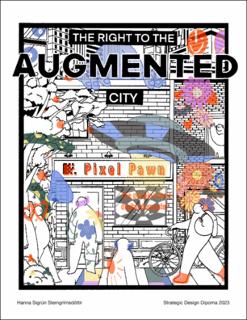The Right to the Augmented City
Master thesis
Submitted version
Permanent lenke
https://hdl.handle.net/11250/3073552Utgivelsesdato
2023-06Metadata
Vis full innførselSamlinger
- Design [217]
Beskrivelse
This project argues that if citizens have the right to the city, they should also have the right to the augmented layer, especially in public spaces.
The augmented city envisions a future where augmented reality becomes a new digital public infrastructure, mediating interactions between citizens and their city. Instead of focusing on a single app augmenting a specific location, this project examines the impact of an ecosystem of augmentations facilitated by private companies. This exploration includes examining ownership models that may emerge as AR technology becomes more prevalent in urban environments.
The primary goal is to explore how strategic design can mediate the power dynamics behind location-specific digital content. By developing digital protocols that prioritize citizens’ right to the digital commons over private tech companies, the aim is to contribute to the field of design and provide a citizen-centric perspective. Drawing on concepts such as placemaking, Henri Lefebvre’s “right to the city,” and Sabina Andron’s “right to the surface,” the project approaches the speculative AR-layer from a citizen-centric perspective, considering various scales and policy implications.
The final deliverable consists of building blocks that propose an alternative approach to crafting the augmented city. These building blocks propose new digital rights for citizens, emphasizing access, contribution, context, and protection. The intention is to embed collective urban values into the design, broadening the notion of citizenship to include the digital realm.
The project aims to offer a novel perspective that contributes to the discourse on AR technology, particularly from a design perspective. It seeks to provide a lens for relevant stakeholders to approach the use of AR technology. This perspective is crucial in evaluating the implementation of the AR-layer in cities, as the profit potential associated with AR may incentivize big tech to dominate the space, influencing frameworks and values embedded in public places. Recognizing the digital layer as an influencing factor in urban space production directly impacts citizens and their right to the city. It becomes a question of how we choose to allow it.
Valuing the digital layer alongside the physical environment is essential in establishing the AR layer as a new dimension of space in cities. The digital layer represents a new domain of citizenship, influencing how citizens perceive and live within the real world. Cities must consider citizens’ rights before solidifying the AR-layer, enabling them to proactively build a digital public infrastructure that addresses the issues observed in current digital platforms. Design plays a pivotal role in shaping this future, and it is our responsibility to ensure its positive impact on society.
